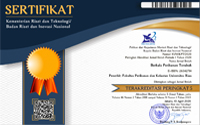ANALYSIS OF GOOD MANUFACTURING PRACTICE AT HOME INDUSTRY FOR CATFISH FLOSS IN PURWOSARI, KEDIRI REGENCY
Abstract
Keywords
Full Text:
PDFReferences
Badan Standarisasi Nasional (BSN). 2013. SNI 7690:2013. Abon Ikan. Jakarta.
Fachruddin, L. 1997. Membuat Aneka Abon. Kanisius. Yogyakarta.
Hariyadi, P. 2008. Teknologi Penggorengan. Food Review Indonesia, 3 (3). April 2008.
Junianto 2016. Manajemen Industri Hasil Perikanan. Unpad Press. Sumedang
Junianto. 2003. Teknik Penanganan Ikan. Penebar Swadaya. Jakarta.
Liviawaty, E. dan E. Afrianto. 2010. Penangann Ikan Segar. Widya Padjajaran. Bandung.
Maniagasi, R., S. Sipriana, Tumembouw dan M. Yoppy. 2013. Analisis Kualitas Fisika Kimia Air di Areal Budidaya Ikan Danau Tondano Provinsi Sulawesi Utara. Jurnal Budidaya Perairan.1 (2).
Moerdjoko. 2004. Kaitan Sistem Ventllasi Bangunan dengan Keberadaan Mikroorganisme Udara. Fakultas Teknik Sipil dan Perencanaan. Universitas Kristen Petra
Nastiti, A.S., S.Nuroriah dan S.E. Purnamaningtyas. 2001. Dampak Budidaya Ikan dalam Jaring Apung terhadap Peningkatan Unsur N dan P di Perairan Waduk Saguling, Cirata dan Jatiluhur. Jurnal Penelitian Perikanan.
Nazir, M. 2005, Desain Penelitian, Cetakan ke dua. Penerbit Erlangga. Jakarta
Purnawijayanti, A. H. 2001. Sanitasi, Higiene dan Keselamatan Kerja dalam Pengolahan Makanan. Kanisius. Yogyakarta.
Sucipto, C. D. 2015. Keamanan Pangan untuk Kesehatan Manusia. Gosyen Publishing. Yogyakarta.
Sulthoniyah, S. T. M., T. D. Sulistiyati dan E. Suprayitno. 2013. Pengaruh Suhu Pengukusan Terhadap Kandungan Gizi dan Organoleptik Abon Ikan Gabus (Ophiocephalus striatus). THPi Student Journal. I (1): 33-45
Sunarya. 2014. Mutu dan Keamanan Pangan Hasil Perikanan. CV. The Spring. Bogor.
Suryani, A., E. Hambali dan E. Hidayat. 2007. Membuat Aneka Abon. Penebar Swadaya. Jakarta.
Wulandari, A. dan S. R. Nunuk. 2009. Perbaikan Teknik Pembuatan Keripik Menggunakan Penirisan Minyak di Sentra Industri Makanan Ringan Dusun Jiwan, Gondangan, Jogonalan, Klaten. Jurnal Prospect Februari 2009, Tahun 5 Nomor 8. Hal 39-44.
DOI: http://dx.doi.org/10.31258/terubuk.47.2.126-133
Refbacks
- There are currently no refbacks.
Copyright (c) 2019 Susetyo Ilman Rosyadi, Eddy Afrianto, Achmad Rizal, Rusky Intan Pratama

This work is licensed under a Creative Commons Attribution 4.0 International License.












